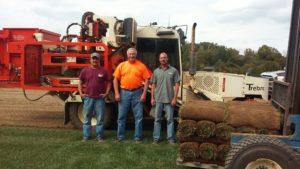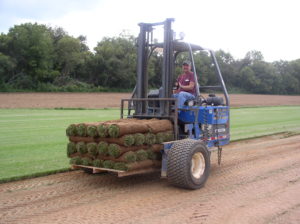
The Bass family transitioned their 97-year-old farm from a tobacco operation to a sod and soybean farm.
By Anthony Landrum, County Executive Director
Walter Edward Bass started the legacy of Bass Farms when the family relocated from Lennig, Virginia, and purchased a farm near Gladys, Virginia in 1921. The farm is quickly approaching the status of a Centennial Farm – a farm continuously owned by a single family for 100 years or more.
The Bass family has seen many changes in their operation over the last four generations. The biggest adjustment – transitioning from tobacco and cattle production to soybeans and sod.
For many years, the Bass family were successful tobacco and cattle producers. Before 2014, Walter B. Bass, Jr. and sons, Walter (W.B.) and Allen, produced upwards of 165 acres of flue cured tobacco, two to three acres of burley and Virginia dark fire tobacco, in addition to small grains and beef cattle.
The family began exploring other commodities shortly after the Fair and Equitable Tobacco Reform Act of 2004 ended the tobacco quota program and established the Tobacco Transition Payment Program (TTPP). TTPP was administered by the USDA Farm Service Agency (FSA) until 2014.
Within the next 10 years, the Bass family made the transition from a tobacco and cattle farm to a sod and soybean farm. Today, they grow 200 acres of sod and 800 acres of soybeans.

Today, they grow 200 acres of sod and 800 acres of soybeans.
Hard work and attention to detail has helped the family make their operation’s transition a success. The Bass family credit some of their success to their participation with FSA’s Marketing Assistance Loan (MAL) program. MALs provide producers interim financing at harvest time to meet cash flow needs without having to sell their commodities when market prices are typically at harvest-time lows. This enabled the Basses to realize a greater profit on their soybeans by allowing them to utilize a higher market price.
“Working with FSA has brought us great benefit in the past,” says the elder Bass. “They have been very helpful during our transition.”
To further protect the Basses from market shortfalls, they also participate in the Agriculture Risk Coverage (ARC) and Price Loss Coverage (PLC) programs, which can provide a crucial safety-net.
Growing sod is a year-round event requiring close attention. Preparing the land is an important step in growing sod, as it impacts every aspect of the growing and harvesting process.
“Anything you build or grow is no better than the foundation you begin with,” Walter said.
Once the grass seed is sown, fertilized and the netting is applied, the manicuring process begins. Proper attention must be given to irrigation needs, spraying for any possible disease, especially during really hot, humid weather.

The farm grows four types of sod and once harvested, it must be delivered within 24 hours.
Each fall the land preparation process starts all over again. The Bass family pays close attention to refurbishing the land, as every time they harvest, a quarter inch or more of top soil is removed. Once an order is placed, the Bass brothers schedule the proper time to harvest the sod as it must be used within 24 hours.
The Bass Sod Farm produces four types of sod- Fescue, Zoysia grass and two types of Bermuda grass. The Bass family pride themselves in providing a high-quality product stating “a quality product will sell itself.” They market their product through word-of-mouth advertising, with most of their sales to repeat customers within the local area and customers in other mid-Atlantic states.
For more information on FSA programs, contact your local FSA office or visit www.fsa.usda.gov. To find your local FSA office, visit farmers.gov.





